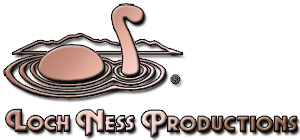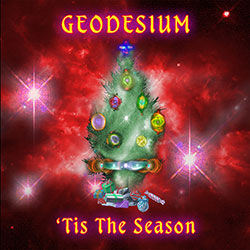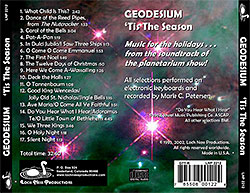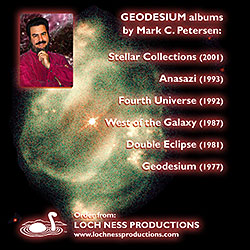'Tis The Season liner notes
The planetarium show 'Tis The Season is one of the richest-sounding of all Loch Ness Productions show offerings to date. It certainly has a wide variety of instruments and musical selections. We thought we'd relate a few items about this soundtrack music, since much of it is differs from the characteristic Geodesium space music style.
All the music was performed and recorded by only one person — Mark C. Petersen, using his nom-de-plume Geodesium. He used an extensive array of electronic keyboards, most notably an E-mu Systems Emulator II+HD. This is a sampling keyboard; it outputs digitally recorded samples of instruments when its keys are played — from cymbals to orchestral strings to brass and choirs.
The relatively short durations of the tracks is a result of how they were used in the show — that is, as underlying beds, setting the framework over which narration tracks were mixed. While featured prominently here in the foreground on this album, the voice of the narrator, Noah Adams took aural center stage in the show's soundtrack.
What follows is a list of the songs in 'Tis The Season, and the instrumentation used. Mark offers some notes about some of the selections.
1. What Child Is This? — flute, voices, wind chimes, wind. In trying to create a windy wintry sound for the opening and closing pieces, I chose breathy voices; there are several layers of filtered pink noise wind. I've added some "ice crystals" to the wind gusts in the form of high tinkly wind chimes. These only appear at peaks of the wind whooshes, which I timed to fall in between sentences and paragraphs, so they don't get buried by the narration. The flute melody wafts in, as if carried on the wind.
2. Dance of the Reed Pipes, from Tchaikovsky's The Nutcracker — violins, violas, celli, basses, flutes, English horn, bass clarinet.
3. Carol of the Bells — handbells, choir, bass voices. While it starts out as typical space music, starry and twinkly, after a while it should begin to sink in that the tune is Carol of the Bells. The voices, especially the bass ones, fill in the gaps for the depiction of the sun's arc across the sky, depicted by the planetarium projector's annual motion.
4. Pat-A-Pan — shawm, curtal, voices, tambourine, drum. To get the primitive feel of the time, I used two Renaissance period instruments, the shawm and curtal. It's a French carol, used when depicting a Celtic scene in the show, but I think it works.
5. In Dulci Jubilo/I Saw Three Ships — harp, pan pipes, tambourine, drum. I envisioned little Roman satyrs playing pan pipes, strumming lyres, dancing around during the pagan Saturnalia celebration.
6. O Come O Come Emmanuel — trumpets, French horn, trombone, tuba, synthesizer choir. I used the traditional harmony the first time through, and a more modern harmonization, from an arrangement my brass quintet has, the second time around the tune. We've even got the brass quintet playing in there (via Emulator).
7. The First Noel — piano. I'm doing my George Winston impression here.
8. The Twelve Days of Christmas — sleigh bells, harpsichord, synthesizers, snare drum, piccolos, male voices, female voices, shakuhachi, brass, strings, chimes. The energetic "Twelve Days" music serves the function of the proverbial "mid-show wakeup", the tenet dictated in chapter four of the Above-Average Planetarium Producer's handbook. The choice of instrumentation seemed almost dictated — a snare drum for 12 drummers, piccolos for the pipers, male voices for the lords, female voices for the ladies, a wolf-whistle for the fair maidens, quacking kinds of sounds for the swans and geese, and metallic chimes and bells ringing for the rings.
9. Here We Come A-Wassailing — synthesizer, recorder, hammered dulcimers, guitar, trumpet, brass, castanets. The tune is English, which isn't too far from the Norway scene in the show. For the Irish cottage scene, I rationalized the hammered dulcimer is a lot like the psaltery, a harp often used there. Then the mariachi band comes marching in for the Mexican section, complete with castanets. Olé!
10. Deck the Halls — marimba, xylophone, glockenspiel, synthesizer, cymbal, bell.
11. O Tannenbaum — oboe, piano, trumpet, choir.
12. Good King Wenceslas/Jolly Old St. Nicholas/Jingle Bells — sleigh bells, synthesizers.
13. Ave Maria/O Come All Ye Faithful — choir, synthesizer, cello. This is a little snippet of the Bach-Gounod Ave Maria, which isn't as well known as the Shubert, but still familiar. It's primarily just the chords, not so much the melody.
14. Do You Hear What I Hear/Adoramus Te/O Little Town of Bethlehem — harp, space horn, bass sequencer, voices, synthesizer, choir, flute. Geodesium fans will recognize the style in this medley — the bass sequencer, light percussion, and rippling harp arpeggios. We're doing the stuff of planetaria here in the show — stars, planets, comets, meteors, etc. — so it calls for my "classic" space music accompaniment. The music for the lunar eclipse is the Latin hymn, which the choir sings, of course. I felt compelled to add a flute counterpoint.
15. We Three Kings — low strings, bassoon, English horn, oboe, harp, tambourine, chimes, timpani, orchestral bells, choir, cymbal. Again, the choice of We Three Kings was pretty much dictated by the show script — what else could we have for camels and the Star of Wonder? I chose some double-reed sounds for the melody to convey a Mid-Eastern "Persian" spirit. The orchestration builds and builds, as we come up to the conjunction climax.
16. O Holy Night — flute, guitar. There's quite a comedown from the energy of the previous piece, but fortunately it's is so pretty that it works. I paid particular attention to the phrasing of the flute, to emulate a wind player's breathing.
17. Silent Night — voices, wind. The melody is there, but very subtle. I couldn't resist the plagal cadence.
Finally, a note about the cover art: while there is a Christmas tree with presents beneath it, virtually everything else comes courtesy of the Hubble Space Telescope. The ornaments are planetary nebulae; the tree itself is a planetary nebula, NGC 5307, (featured solo on the inside front cover). CRL 2688 tops the tree, above NGC 6826, NGC 6543, NGC 7009, IC3568, IC418, NGC 7662, and M2-9 flanked by a pair of MyCn 18s. A blend of NGC2440 and stars of the Trapezium in M42 appear behind the tree and on the label; the unfettered Trapezium on the tray card.





